Learn the differences between leads, prospects, and opportunities. Understand how to turn leads into prospects and opportunities.
A one-page proposal is a single-page document that outlines the value and terms of a deal you’ve discussed with a potential buyer. It serves as an effective alternative to a full-blown proposal when the deal terms are simple, the price tag is small, there’s an existing client relationship, and more. In some cases, it can also serve as a precursor to a larger proposal, and it's best created using a customizable template.
While it's fine using a generic template, consider custom-designing your one-page proposal to help it stand out. Hire a designer on Fiverr, which is a gig-based marketplace with expert designers offering custom proposal designs starting at five dollars. Hire a proposal design pro to create a one-page proposal you can update and send to each prospect as a PDF. Check the top options here:
A one-page proposal is a document sent during the business proposal stage of your sales process outlining the deal terms with a prospective customer. A one-pager typically includes the following sections: proposal scope, project overview, deliverables, cost, timeline, terms, next steps, and contact information. It’s used when a longer proposal isn’t needed and can be sent physically, as an email attachment, or in the body of an email itself.
One-page proposals are used to close deals quickly with a comfortable prospect when robust lead nurturing isn’t needed. One-pagers differ from full business proposals in that they’re scaled-down with much of the same information. The one-pager leaves out elements that you would’ve included in a full proposal, like your business’s credentials or executive summaries. This reduction in information is generally makes it easier to create and understand, so they speed up the sales cycle.
A one-page proposal is best for the following scenarios:
If this doesn’t sound like your situation, consider using a full-length business proposal so you can include more information for the prospect in the document. Learn how to craft one in our article on how to create a business proposal — it comes with a free template that you can customize.
Here’s a free one-page proposal template that you can download in multiple formats and edit to fit your needs. It’s completely customizable and designed to be personalized to your client. We’ve incorporated corresponding and written out examples from the template within the steps to writing a one-page proposal.
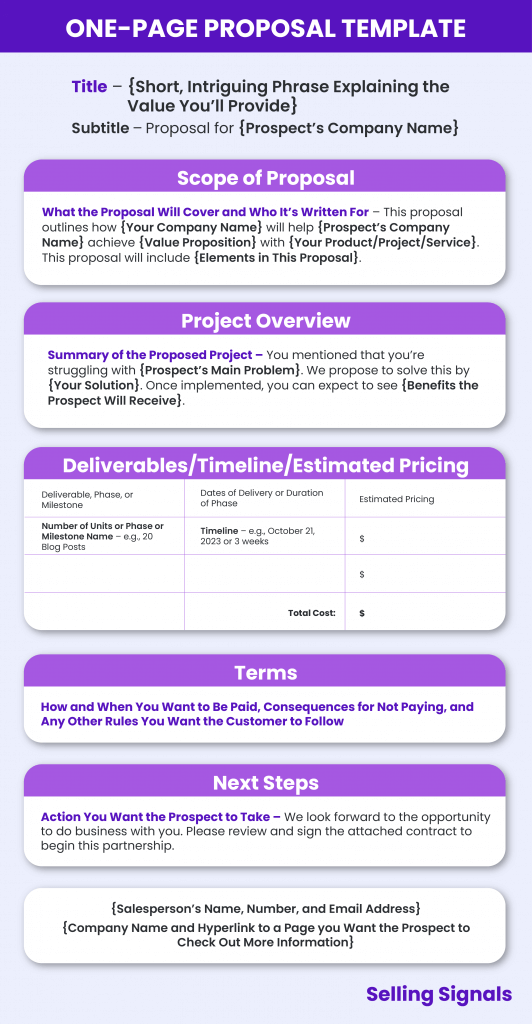
Even though your one-page proposal should be personalized to each prospect or customer, all one-page proposals follow a standard format. This format includes sections such as your project scope and overview, deliverables and cost, terms, next steps, and your contact information. Your one-page proposal should include the following sections, customized to your specific recipient:
Your title and subtitle should be intriguing and engaging but also clearly communicate what your recipient is about to read. Don't get complicated here — keep it short and to the point.
The scope of your proposal should give a high-level overview regarding what your one-page proposal will cover and who it's intended for. The project overview gives a summary of your project or deal you're proposing. These elements can be included together in one section or broken out in their own sections.
Next, outline the deliverables of your proposed solution along with the timeline for those deliverables and the associated costs. The easiest way to express this is in a table format with each deliverable listed along with a timeline and cost. Then, sum everything you've listed to get a total timeline and cost.
After the deliverables, timeline, and costs have been stated, outline the deal terms of your proposed solution. This should include payment terms as well as any other terms you want your customer to agree to.
With clear and concise messaging, all of the above components can fit onto one page. Since you’ll be drafting this proposal with limited space, it’s important to make each component as effective and efficient as possible. Continue reading for step-by-step instructions on how to write the best one-pager including further insight into these components with examples.
An effective one-page proposal should result in a closed deal. Each proposal will be personalized to each new prospect, and the details you include should change with their needs. But regardless of who’s receiving it, there are eight steps to follow to ensure your proposal answers all of the questions on the buyer’s mind. Here are the steps to writing a one-page proposal, using screenshots from our template throughout as examples:
First, identify everything you know about your deal, including information about your client, your solution, the timeline, what you need from them, and more. Don’t hold back. This process will help you organize and prioritize details before sitting down to actually write your proposal. That way you’ll avoid running out of space on the document. Distilling all the knowledge about a deal into one page is trickier than it sounds.
Now, with all the information in front of you, start to highlight or underline the details that are most relevant and interesting to your prospect. To help you select this information, think about the key questions your prospects want answered before they agree to start paying you. Answering these will speed up the deal by decreasing the number of follow-up objections or questions they have.
Your one-page proposal should resolve the following questions for your prospect:
And don’t forget to think about yourself and what you need out of the agreement, especially if you’re using the one-page proposal as a legally binding contract. Specifics like how and when you’ll be paid and any rules you want the prospect to follow should also earn a highlight or underline. Now, let’s start actually creating your one-page proposal using this vital information.
Your prospect is likely busy, especially if they are a high-level executive who asked you to send them just one page. Take that into account when crafting a title. Use it to give them context about what this document is. Also, use the title to summarize the rest of the proposal, as a proposal letter might do for a 10-page proposal. Lastly, make it appeal to their interests. Of course, doing all this in just one phrase is no easy task. But have no fear, we’ll help you out.
First, let’s look at a boring one-page proposal title: “Business Proposal for {ABC Company}.” While that works for a subtitle, the title above it is the first thing your prospect will read, so it should spark their interest. Make use of the limited space you have and create an intriguing title that answers the busy prospect’s one vital question: “Why does this matter to me?” Do this by writing the specific value or solution you’ll be providing the prospect.
Here are some examples of turning lifeless titles into ones that nearly dance off the page.
Dead Title: Prop-Tech Proposal for ABC
Living Title: Slashing Your Violation Fines With Compliance Monitoring Software
Dead Title: Sales Training Business Proposal for XYZ
Living Title: Training Your Reps to Open 50% More Sales Opportunities
Dead Title: Marketing Consulting Proposal
Living Title: A Content Marketing Plan for Increasing Quality Traffic to {Website}
You can use this title as a heading for the one-page proposal itself, or even as the email subject line if you’re sending it via email. You can add a subtitle below to explain exactly what the document is or add any more information you might think is critical for the prospect to see right away.
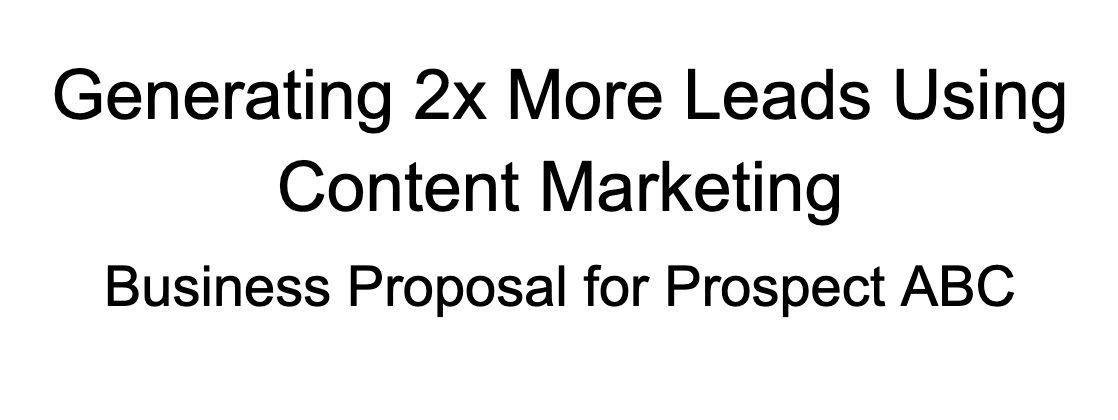
Title example
Tell the prospect what this short proposal will cover. This paragraph acts as an introduction and agenda. It should be about two sentences long. The first sentence will tell them what you’ll help the prospect accomplish or what solution you provide. This includes your value proposition that has been customized to your prospects’ needs.
The second should describe what elements are included in the proposal. It’s essentially just giving the reader context so that they know what to expect as they read through. This will answer a question on the prospect’s mind: What’s this document going to tell me?

Scope of proposal example
Now give a summary of the project. This overview should tell the prospect what problem you’re solving for them, how you’re going to do it, and the main benefits they’ll receive after your service or product is delivered in full. This paragraph of about 3-4 sentences (aim for under 200 words) should give the buyer a sense that you fully understand their unique objectives and that you have a solid approach for achieving them.
This section should answer two big questions for the buyer:
Be sure to make this section about them rather than yourself. Hone in on the main pain point that makes their blood boil. And, to really speak to their heart, bring up phrasing that they used when telling you about the issue in your past conversations. Also, speak about the solution using similar terminology from when you shared it with them in your presentation or side-talks.
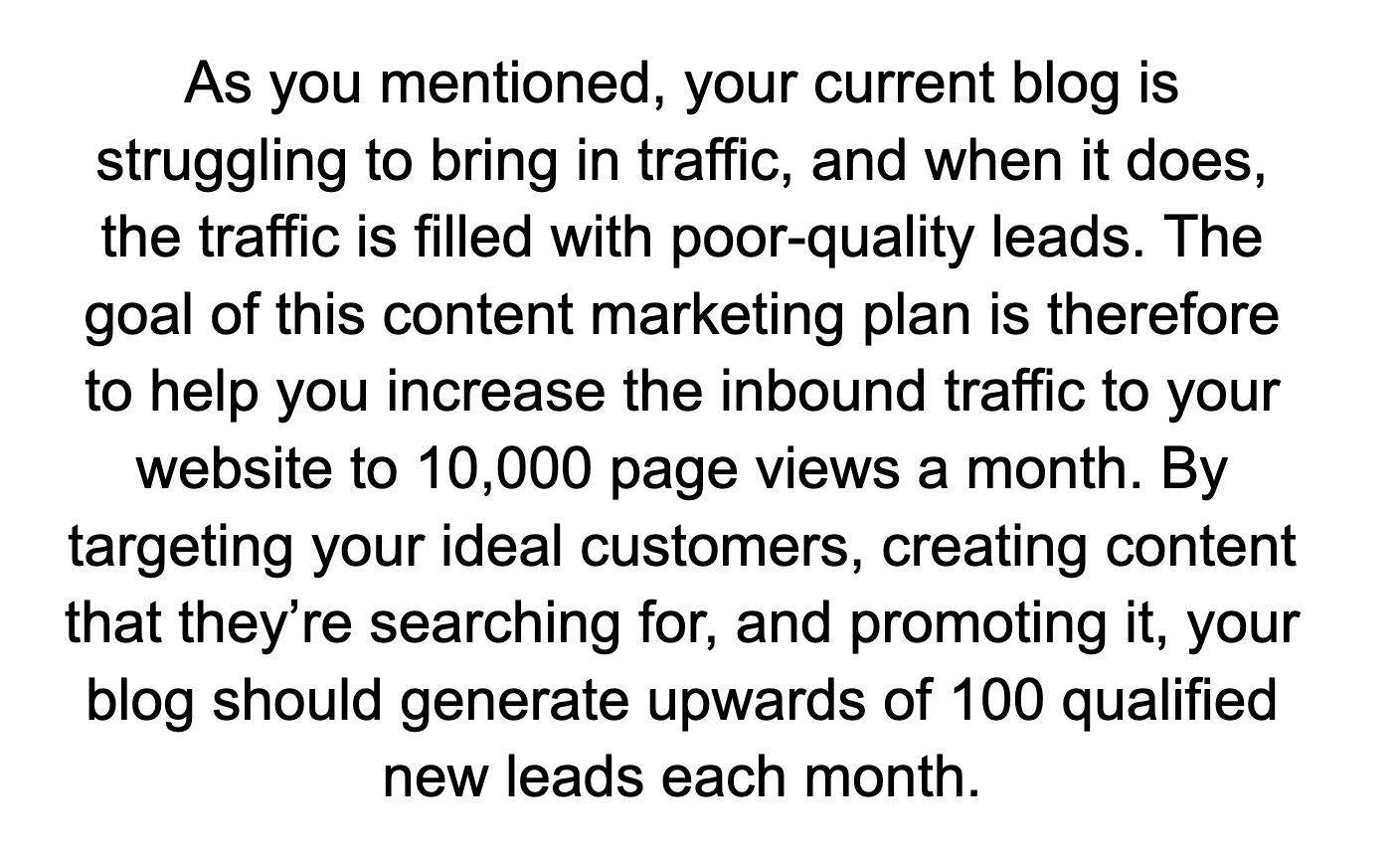
Project overview example
You don’t necessarily need to portray this information in a table, but it’s a great way to save space. In one table, you’re able to say exactly what the prospect will receive, when they’ll get it, and how much they’re going to pay for it. Plus, this way, you break up the pricing into smaller parts of the whole, assigning costs to each deliverable or phase of the service. This breakdown makes the overall cost easier to understand and therefore accept.
Now let’s discuss these three portions of your table so that you understand the key points to include and how to customize each one to fit your unique business situation.
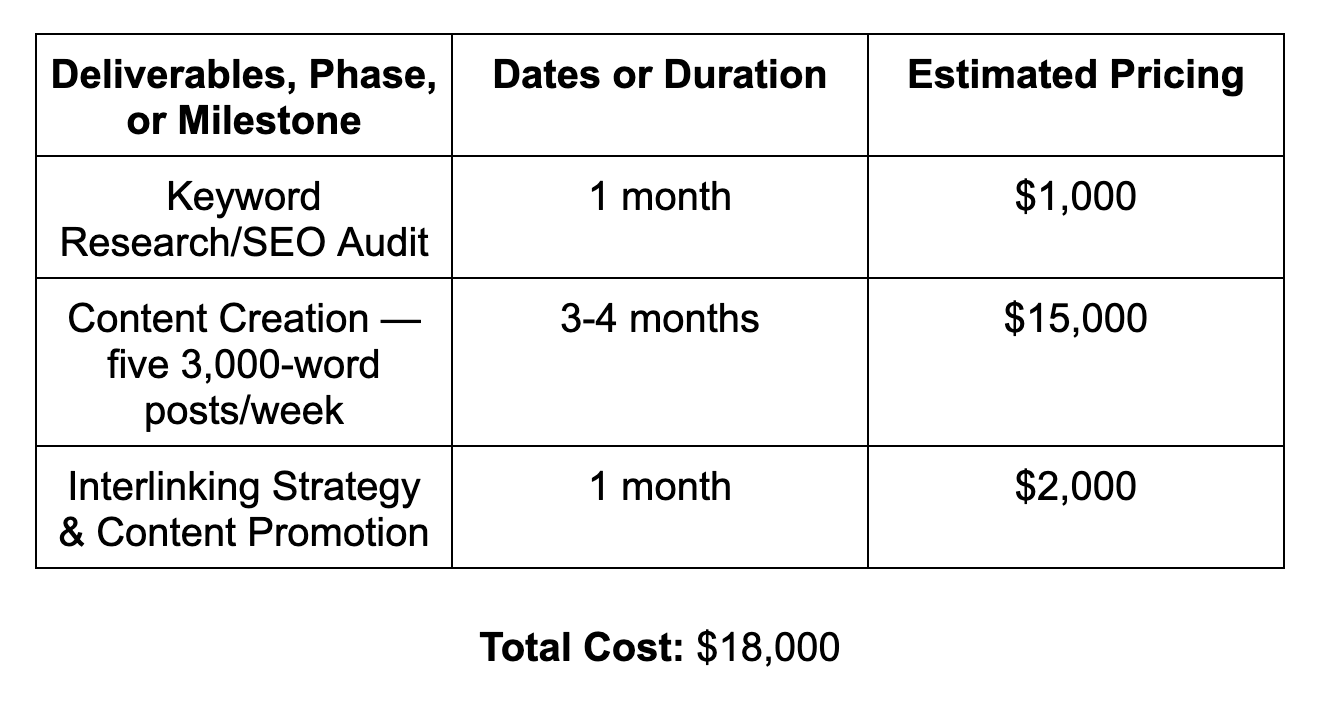
Deliverables, timeline & pricing example
These are the rules of the agreement you and your prospect will be held to. It outlines what you expect from the prospect, primarily in regards to the payment. Stipulate how you’d like to be paid and if recurring payments are required, on what dates. Also, if you need access to certain accounts or want them to follow any rules, such as communicating with you only by email, include this in the terms section.
This is also where you can include any industry-specific terms to the proposal. Since this is just a one-page proposal, many companies use an attached contract to do the heavy lifting for the legal aspects of the deal, so they’ll just include the payment terms here.
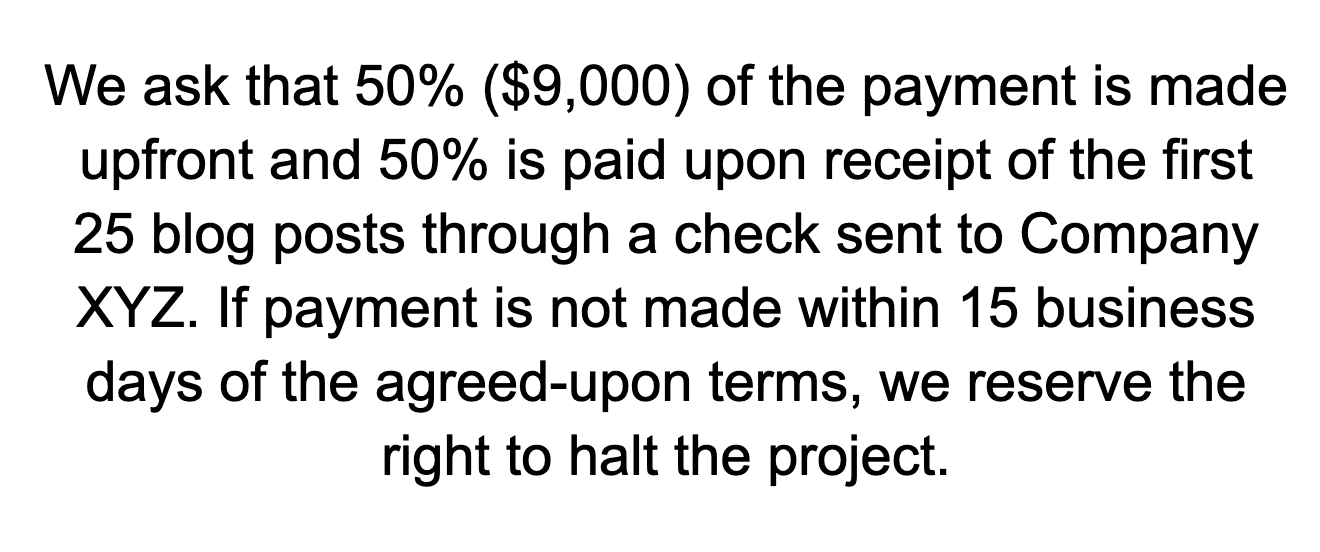
Terms example
Finally, make your call-to-action. If you have a separate contract you want them to sign, tell them where it’s located and give any necessary information about how to sign it. The contract will give more specific terms about the legal aspects of the deal, which the proposal may only summarize. If you’re working in a corporate environment with high-priced solutions, you might have contracts that are much longer than the one-page proposal.
If you want to learn more about how to use these two documents together, read Matt Olpinski’s article on the difference between contracts and proposals. If you’re using this one-page proposal as a contract, add a space or line for them to sign and date the document — either physically or using electronic signature software. Clearly state that this will be a legally binding contract once signed.

CTA example
Give your prospect an easy way to contact you should they have any questions or to learn more about your business. At the bottom of the document, write your name, your business’s name, and your contact information. Letting your prospect know you’re their main point of contact throughout this process helps build trust in the partnership.
On the next line, link to your company’s “about us” page. If you have client testimonials, a portfolio, or case studies you’d like the prospect to see, link out to these pages in this section. This will help show your credibility in the eyes of the prospect.
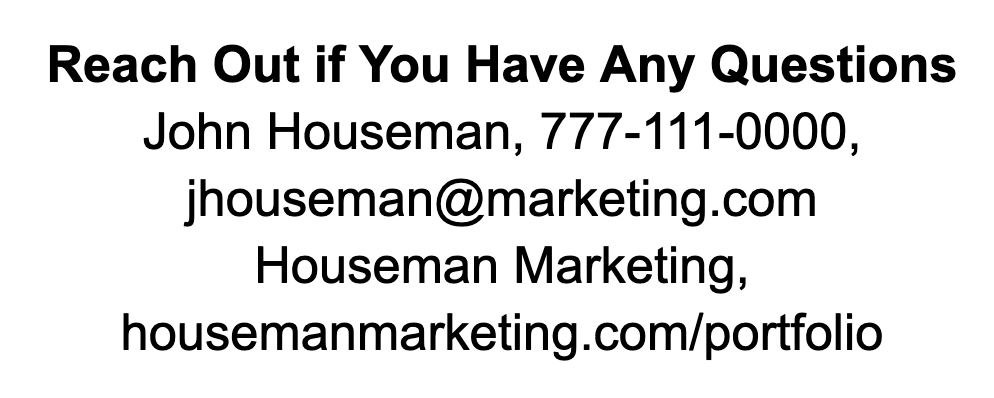
Contact info example
Following these defined steps will help you create a catchy and effective one-page proposal for your prospects. If you want to explore more resources for one-pager templates and examples, we've gathered the 5 best situational proposal examples below. Check them out along with our best practices and you'll be able write up your own one-pager in no time.
Before you write your own one-page proposal, take a peek at some examples. From these, you’ll gain inspiration, ideas, and strategies that you can then apply to your own proposal. Let’s dive into these proposal examples and see why they work:
These examples cater well to specific scenarios depending on your product or service. Feel free to take your favorite parts of each to make your own customizable proposal. While you’re crafting your one-pager, consider the following best practices to ensure you’re writing a strong proposal.
There are some best practices that can set your proposal apart from the competition. Let’s go over three of the most impactful proposal tips: use smart formatting, employ copywriting tactics, and leverage proposal management software.
In this type of proposal, you have to fit a lot of key points into one page. Proper formatting techniques will be your friend in this task. Smart formatting also ensures that the page seems clean and calm rather than messy and busy. This makes the reading experience more pleasant for the prospect so they have positive emotions while thinking about your product or service.
Here are some formatting tactics:
These formatting methods will help you fit everything that’ll help close the deal onto the page.
Copywriting is sales in the written word. In longer form sales documents, like the proposal, copywriting tactics keep the reader engaged and excited to keep reading. They also make sure the sales messaging is clear and easy to understand. Here are a few tricks of the trade.
These copywriting tactics should help you keep the prospect’s eyes open wide with interest and moving down the document.
Proposal management software refers to web-based platforms designed to automate and streamline proposal creation, management, and analysis of effectiveness. They also come with one-page proposal templates you can download, edit, and send. Then, you can track each proposal’s close rates and improve them over time. Read our article on the best proposal management software to learn more about how they work and to choose the right one for you.
However, if that sounds like too much and all you need is a software platform that enables you to include esignatures on your proposals, we recommend electronic signature software. These tools allow the recipients of your one-page proposal to easily add their signatures to the digital document from their laptop, mobile device, or tablet. To learn more, check out our guide on the best esignature software.
Once you create a template or completed one-page proposal using proper formatting and copywriting techniques and you get used to your new software, you'll have an easier time creating one-page proposals for future prospects and clients.
Sending a well-crafted one-page proposal has the opportunity to be the final sales action you take to close your deal. In just one page, it can drive home the value of your solution and illuminate the specifics of the project, thereby making the prospect feel ready to sign. If the prospect has any questions, be there to answer them and help them gain clarity. Read our guide on how to close a deal for steps and strategies to get your prospect to commit to the purchase.